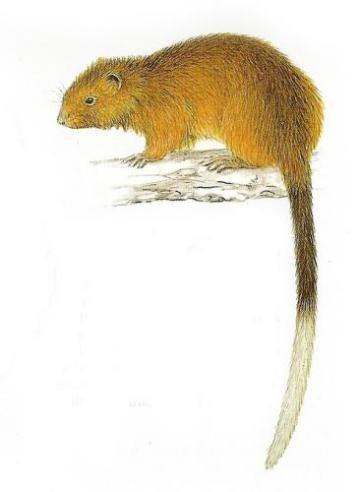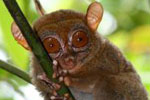Czech computer programmer, Vaclav Rehak, was the first person to see a living Dinagat bushy-tailed cloud rat (Crateromys australis) in nearly forty years, reports GMA News. Rehak was traveling on Dinagat Island with his new wife, Milada Rehakova-Petru, a specialist on Philippine tarsiers, when he stumbled on the rodent, which has only been recorded once by scientists in 1975. Found only on the Dinagat Island, the rodent was feared extinct, but is now imperiled by mining concessions and logging across its small habitat, which is thought to be less than 100 square kilometers.
“My husband, programmer Vaclav Rehak, saw a big hairy rat creeping through the vegetation slowly at the beginning of 2012. A week later, we took the first photographs and video recordings [of the rodent] in the wild,” Milada Reháková-Petru told Czech media, Ceske Noviny. The couple were traveling in a partially protected forest.
 Dinagat bushy-tailed cloud rat. Illustration by William Oliver, Philippines Biodiversity Conservation Foundation. |
The almost orange-colored rodent sports a long tail with a bushy white end. From head to tip-of-tail, the Dinagat bushy-tailed cloud rat is nearly 2 feet (21.6 inches, 55 centimeters) long, making it one of the world’s longest rodents. Currently listed as Critically Endangered by the IUCN Red List, it was thought ‘possibly extinct.’ The Dinagat bushy-tailed cloud rat is also listed as number 99 on the EDGE mammals list, which categorizes species by their threat level and their evolutionary uniqueness.
The species is threatened by chromite and nickel mining as well as continued logging on the island, which is only 967 square kilometers.
Dinagat Island is home to two other rodents found no-where else, including the Dinagat moon rat (Podogymnura aureospinula) and the Dinagat hairy-tailed rat (Batomys russatus), both considered Endangered. The island’s dwindling forests also contain populations of the Philippine cockatoo (Cacatua haematuropygia), listed as Critically Endangered; the white-winged flying fox (Pteropus leucopterus), Endangered; the crested lizard (Hydrosaurus pustulatus), Vulnerable; and the Philippine tarsier (Carlito syrichta), Vulnerable among others. The Philippines are considered a global biodiversity hotspot, but many of its species are on the edge of extinction.
Rehakova-Petru and William Oliver of the Philippines Biodiversity Conservation Foundation (PBCF) are authoring a paper on the discovery.
To see the video: Ceske Noviny article with video.
Related articles
Tiny tarsier makes big, ultrasonic noise

(02/13/2012) The Philippine tarsier (Tarsius syrichta), a 5-inch tall Southeast Asian primate, has long resembled a ventriloquist’s doll. It would open its mouth as though chattering away, but researchers heard nothing. Now, a new study in Biology Letters has found out why: the Philippine tarsier communicates ultrasonically, surpassing all other primates, and nearly all terrestrial mammals, in its ability to create sounds in the upper registry.
Giant snakes commonly attacked modern hunter-gatherers in Philippines

(12/13/2011) Humans have an ambivalent relationship with snakes. The legless reptiles are often feared and reviled, becoming stand-ins for the Devil and movie monster characters; yet many people have grown to love snakes, raising large, even dangerous, specimens as pets. Now, new research suggests that the ecological role between snakes and humans, as well as other primates, is more nuanced than expected. After spending decades living among the Agta Negritos people in the Philippines, anthropologist Thomas Headland has found that the hunter gatherer tribes were quite commonly attacked by reticulated pythons (Python reticulatus), while the people themselves had no qualms with hunting, killing, and consuming python.
Authorities capture the biggest crocodile ever recorded (PHOTO)
(09/06/2011) Authorities in the Philippines captured the largest crocodile on record after a series of fatal attacks, reports Agence France-Presse (AFP).
Photos: 300 species discovered during expedition to Philippines
(06/26/2011) Scientists believe they have discovered more than new 300 species during a six-week expedition to the Philippines.
7 new mice species discovered in the Philippines
(06/16/2011) Seven new species of mice have been discovered in the rainforests of Luzon island in the Philippines, according to the country’s Department of Environment and Natural Resources.
On the edge of extinction, Philippine eagles being picked off one-by-one
(05/23/2011) Down to a few hundred individuals, every Philippine eagle is important if the species is to survive. However, the Philippine Eagle Foundation (PEF) has recently announced that people continue to illegally trap and keep eagles captive. Since December the organization has taken-in four confiscated Philippine eagles (Pithecophaga jefferyi), according to The Philippine Star. One died of a fungal infection after confiscation, while two others has suffered serious injuries.
Forgotten species: the subterranean Gekko gigante
(04/08/2010) Travelers to tropical destinations are likely familiar with the gecko. Clinging to walls and ceilings of buildings—sometimes staring down at you from the bedroom ceiling or glancing at you quizzically from the bathroom door—the small adhesive-footed lizard could be aptly described in some tropical areas as ubiquitous. Despite the apparent commonness of some species, geckos are delightful lizards with round wide eyes, a thick gripping tongue, and of course that amazing knack of seemingly defying gravity with specialized toe pads. But not all geckos are as easily found—or as common—as those hanging out, literally, in a jungle lodge. The Gekko gigante, also known as the Gigante narrow-disked gecko, has been little- noticed by the public. Even scientists know little about the lovely gray-and-blue gecko beyond the fact that it lays its eggs on cool moist cave walls in two Philippine Islands.
Photo: Fruit-eating dragon discovered in the Philippines
(04/07/2010) Scientists have discovered a new species of giant lizard in the unlikeliest of places: a highly populated, deforested landscape in the Philippines.
